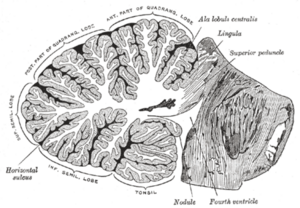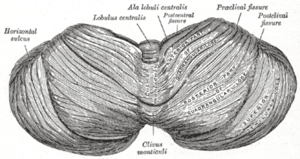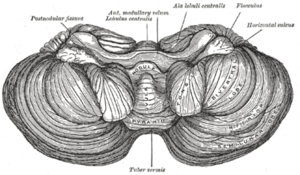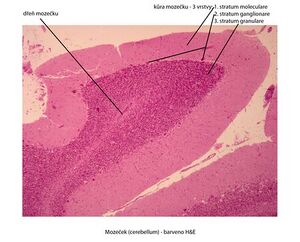The Cerebellum
__OBSAH__
The cerebellum (cerebellum) is located in the posterior cranial fossa, dorsal to the elongated spinal cord (medulla oblongata) and pontus (brain stem).
A rounded dorsally arched structure. A round, longitudinal, narrow middle band, separated by sagittal depressions from the lateral parts = vermis cerebelli' (cerebral worm). Hemisphaeria cerebelli': 2 lateral, larger, symmetrically constructed hemispheres. The cranial surface is flatter, contact with the roof-like duplicature hard membranes of the brain (tentorium cerebelli). Dorsal and caudal surfaces arched; stored in the pits of the occipital bone under the transverse arms of the eminentia cruciformis (fossae occipitales cerebellares). The falx cerebri extends between the hemispheres of the cerebellum (from the crista occipitalis interna).
From the brainstem, 3 pairs of stems, pedunculi cerebellares' enter the cerebellum:
- Inferiores (corpora restiformia) - connect the oblongata with the cerebellum; they line the caudal part of the fossa rhomboidea.
- Media (pontini; brachia pontis) - connect the pons with the cerebellum; they border the fossa rhomboidea.
- Superiores (brachia conjunctiva) - connect the tegmentum mesencephali with the cerebellum; they border the rostral part of the fossa rhomboidea.
All peduncles contain pathways going to and from the cerebellum. Between the pedunculi cerebellares superiores the velum medullare superius (craniale) is opened - the front part of the ceiling IV. chambers, drawn up into a peak called the fastigium.
On the surface of the cerebellum, numerous transverse furrows - they separate individual sections on the vermis and hemispheres = fissurae cerebelli. The largest and deepest fissures separate 3 hl. sections: lobi cerebelli. Smaller fissures further divide these lobes into lobules: symmetrically placed on the hemispheres; correspond to an odd section on the vermis. The smallest fissures separate the parallel strips of the surface of the cerebellum = folia cerebelli. Surface covered by continuous gray matter: cortex cerebelli. Fissura prima - from the center to both sides, fissura horizontalis - dorsal pole, fissura posterolateralis - separates nodulus and flocculus.
Inside the cerebellum is a white matter, the ``corpus medullare. It extends in the form of plates as laminae albae into the folia of the cerebellum. On a sagittal section, the vermis forms a tree-like pattern (arbor vitae, tree of life).
Paired clusters of gray matter are stored in the white matter: nuclei cerebelli':
- Ncl. dentatus– the largest of the cerebellar nuclei. Two parts: dorsomedial (paleocerebellar) with fibers going to the ncl. ruber and ventromedial (neocerebellar) with fibers going to the thalamus. The appearance of a wrinkled pouch with an opening ventromedially against the mesencephalon. Opening of the pouch = hilum (hilus) nuclei dentati. Thence the path contained in the pedunculus cerebellaris superior.
- Ncl. emboliformis - elongated small nucleus, shape of a blood clot. Filed sagittally at the hilum of ncl. dentatus.
- Ncl. globosus – paired, placed medially from ncl. emboliformis. From several small spherical formations of gray matter.
- Ncl. fastigii – paired, placed most medially at the fastigium, near the midline.
Ncl. emboliformis, globosus and fastigii efferent to the ncl. ruber, reticular nuclei, mesencephalon, pontus and oblongata. All the cerebellar nuclei are the starting point of the pathways coming out of the cerebellum - through them the cerebellum is involved in the movement control system
The nuclei contain the bodies of multipolar neurons on which the axons of the Purkinje cells terminate.
Morphological division of the cerebellum[edit | edit source]
It is divided by transverse grooves into 3 lobes. In each lobe, the lobules are separated by smaller grooves (on the vermis and hemispheres). Morphological division enables a topographical orientation to the cerebellum, but does not correspond to the developmental and functional division.
Description of units[edit | edit source]
Top surface (from front to back)
Vermis ( lobus cerebelli anterior )
- Lingula cerebelli – 1 to several foils resting on the velum medullare superius.
- Lobulus centralis – a square group of foils in the front incisura. (fissula precentralis)
- Monticulus – the larger part of the upper surface of the vermis, hump-shaped; it is divided by a transverse groove into culmen and decline ( fissura prima )
- Folium vermis – the only folium at the incisura cerebelli posterior
Hemispheres
- Vinculum lingulae cerebelli – a narrow white band.
- Ala lobuli centrales – a triangular group of foils in the anterior incisus.
- Lobulus quadrangularis – divided by a transverse groove into the pars sup. et inf. (pars inf. otherwise also lobulus simplex).
- Lobulus semilunaris vulture. – crescent shaped.
Lower surface (it is separated from the upper surface by the fissura horizontalis cerebelli)
Vermis (lobus cerebelli posterior)
- Tuber vermis – protrudes into the incisura cerebelli post. (horizontal fissure)
- Pyramis vermis – the widest part of the worm (fissura prepyramidalis)
- Uvula vermis – an elongated elevation made of several foils (fissura secunda)
- Nodulus vermis – attached to the uvula, rests on the velum medullare inf.
Hemispheres
- Lobulus semilunaris inf – lobulus gracilis joins it.
- Lobulus biventer – convex.
- Tonsila cererebelli – significantly convex groups of horseshoe-shaped folia.
- Flocculus – a stalked group of foils with a curly edge; a rudimentary paraflocculus attaches at the posterior margin.
Division of departments according to development relationships[edit | edit source]
Vestibular cerebellum – the oldest part, the basis of development are the vestibular pathways. It consists of: flocculus, lingula and nodulus.
Spinal cerebellum - the basis of development are the spinocerebellar pathways, it divides the vestibular cerebellum into the front (lingua) and back (nodulus and flocculus) parts. It consists in front: lobulus centralis, culmen, lobulus quadrangularis superior and behind: pyramis, uvula, paraflocculus.
Cerebral cerebellum – develops by afferent from the cortex, through the pontocerebellar pathway. It arises in the middle of the older parts of the cerebellum collectively referred to as the palaeocerebellum. It is then called the neocerebellum (seu lobus medius).
The furrowing of the cerebellum happens gradually. Cerebellum - Summary of Anatomical Description The sulcus primarius (fissura prima) forms the earliest. It separates a part called the anterior lobe (rostralis). This includes the lingua and the anterior part of the spinal cerebellum. The following groove - fissura praepyramidalis defines the lobus medius and lobus caudalis in the area of the vermis. Fissura nodulouvularis - border between lobus caudalis and pars nodulofloccularis.
Division including anatomical and developmental characteristics[edit | edit source]
- Lobus rostralis (anterior) – the anterior rudiment of the vestibular cerebellum and the anterior spinal cerebellum.
- Lobus medius – the largest part, includes the cerebral cerebellum.
- Lobus caudalis (posterior) – posterior spinal cerebellum.
- Lobus nodulofloccularis – part of the vestibular cerebellum not included in the lobus rostralis.
Functional involvement of the cerebellum[edit | edit source]
Supply pathways via the pedunculi cerebellares inferiors, medii, superiors to the cerebellar cortex. The exit of fibers from the cerebellar cortex ends in the cerebellar nuclei.
The Cerebellar nuclei send axonss to the gray matter of the stem (mainly to the reticular formation, ncl. ruber, to [ [thalamus|thalamu]]). From the gray matter, pathways to the spinal cord' influence cells, sending their axons as motor fibers to the skeletal muscles. It directs and controls movement activities and muscle tone, when the vermis participates in the coordination of the trunk muscles and the hemispheres of the muscles of the ipsilateral limbs. [1]
Cerebellar Pathways[edit | edit source]
Afferent pathways mainly go to the cerebellar cortex. Efferentation begins with Purkinje cells (1st neuron) and continues after switching in the cerebellar nuclei (2nd neuron) in centrifugal pathways going outside the cerebellum.
Vestibulocerebellum - lobus flocculonodularis and lingula vermis are connected to the vestibular nuclei of the rhombencephalon, from the ncc. vestibular and ncc colliculi superiores and visual cortical areas, maintaining body balance, spatial orientation.
Spinocerebellum - lobus cerebelli posterior, anterior except for the rostral section of the lingula connects to the spinal cord, af. fibers go from the trigeminal nerve, auditory and visual structures of the CNS and ef. they go to the motor nuclei of the brainstem, their function is motor coordination and they respond to proprioceptive information.
Cerebrocerebellum - via the nuclei pontis connected to the cerebral cortex, af. fibers from the cerebral cortex via the ncc. pontis, ef. they are to the motor thalamus (nc. ventralis anterior and lateralis) and to the cerebral cortex, the function is the coordination and timing of muscle movements.
A) Tracks of the partis nodulofloccularis:
- Afferentation from ncll. vestibulares as tr. vestibulocerebellares.
- Efferentation goes to Deiters nucleus, according to its origin as tr. nodulovestibularis and flocculovestibularis. From ncl. fastigii goes separately tr. fastigiovestibularis (Russell's bundle) along the pedunculus cerebellaris inf. to the Deiters core.
B) Tracks lobi rostralis et lobi caudalis
Afferent pathways:
- Tr. spinocerebellaris post.: Stiling-Clark nucleus - pedunculus cerebellaris inf. - cerebellar cortex (and cerebellar nuclei).
- Tr. spinicerebellaris ant. (Gowersi): crossing in the spinal cord - lateral spinal cord (ventral from tr. spinocerebelaris post) - through the pedunculi cerebellares superiores to the cerebellum.
- Tr. bulbocerebellares: from the nuclei of the posterior spinal cords - uncrossed as fibrae arcuatae externae dorsales or crossed as fibrae arcuatae externae ventrales and fibrae arcuatae internae - through the pedunculus cerebellaris inf.
- Tr. nucleocerebellares: from the nuclei of sensitive cranial nerves.
- Tr. olivocerebellares: from the main olive (older part) and minor olive.
- Tr. tectocerebellaris: from the gray matter under colliculi superiores - velum medullare superius - cortex vermis superior.
- Tr. reticulocerebelaris: from the nuclei of the lateral nuclei of the RF - pedunculus cerebelaris inf. - vermis - to the ipsilateral hemisphere.
- Tr. rubrocerebellaris: after crossing tr. rubrospinalis branches off into - pedunculus cerebellaris sup.
Efferent pathways:
- Tr. cerebellotegmentalis (dentatotegmentalis): from the cerebellar nuclei (mainly incl. dentatus) - pedunculus cerebellaris sup. - FR nuclei of the pontine and mesencephalon.
- Tr. cerebellorubralis (dentatorubralis): via pedunculi cerebelli sup. to ncl. ruber (then using tr. rubrospinalis and rubroolivaris for olive).
- Tr. cerebelloolivaris: via pedunculi cerebelli inf. - contralaterally to the main olive (older part) and secondary olive.
- Tr. cerebellotectalis: via pedunculi cerebelli sup.
- Tr. cerebellothalamicus (embolothalamicus): through the central nuclei of the thalamus to the striatum.
C) Pathways of the lobi medii
Afferent pathways:
- Tr. pontocerebellares: from ncll. pontis, where they cross - pedunculi cerebelli medii - cortex of the cerebellum; the pathway is a continuation of the corticopontine pathway (tr. frontopontinus et tr. occipitotemporopontinus) and cross-connects the hemispheres of the forebrain and cerebellum.
- Tr. olivocerebellares: as in the orbits of the lobi rostralis et caudalis, but it originates from the neooliva (younger part of the ncl. olivaris).
- Tr. corticocerebellares: from the motor area of the frontal lobe - pedunculi cerebelli inf. - to the ipsilateral hemisphere of the cerebellum.
Efferent pathways:
- Tr. cerebellorubrales: conduction as in the eponymous pathway from the previous group of pathways.
- Tr. cerebrothalamici: from ncl. dentatus to the ventrolateral nuclei of the thalamus (further as tr. thalamocorticalis to areas 4 and 6).
Links[edit | edit source]
Related Articles[edit | edit source]
External links[edit | edit source]
- JANČÁLEK, Radim – OAK, Peter. Foundations of Neuroscience in Dentistry [online]. MEFANET, ©2011. The last revision 10/27/2011, [cit. 11/26/201]. <http://portal.med.muni.cz/clanek-560-zaklady-neuroved-v-zubnim-lekarstvi.html>.
- OAK, Peter. Fundamentals of Neuroanatomy and Neural Pathways : Multimedia support for the teaching of clinical and health disciplines [online]. Portal of the Faculty of Medicine of Masaryk University [online], ©2007. The last revision 6/3/2011, [cit. 2011-11-27]. <http://portal.med.muni.cz/clanek-442-zaklady-neuroanatomie-a-nervovych-drah.html>.
References[edit | edit source]
- ↑ ČIHÁK, Radomír. Anatomy 3. 2. edition. Prague : Grada, 2002. 516 pp. ISBN 80-7169-970-5.
Source[edit | edit source]
- BOROVANSKY, Ladislav. Complete human anatomy. 3. reworking Prague: State Medical Publishing House, 1967, pp. 597-1023.






